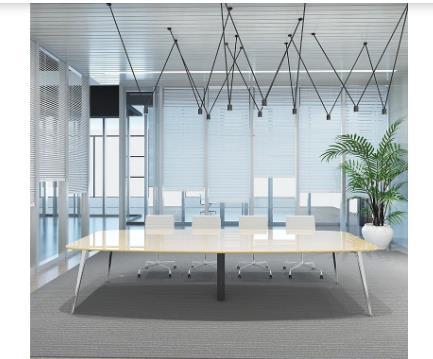Size: The size of the conference table should be appropriate for the size of the room and the number of people who will be using it. A table that is too large or too small can be uncomfortable and impractical.
Shape: Conference tables come in a variety of shapes, including rectangular, oval, and round. The shape of the table should be chosen based on the needs of the business. For example, a rectangular table may be better for presentations and discussions, while a round table may be better for collaborative discussions.
Material: Conference tables are typically made from materials such as wood, glass, or metal. The material should be chosen based on the needs of the business, including durability, style, and maintenance requirements.
Style: The style of the conference table should reflect the style of the business. For example, a modern business may prefer a sleek and minimalist table, while a traditional business may prefer a more ornate table.
Comfort: The comfort of the conference table is important for the people who will be using it. The table should be the right height and have comfortable chairs that provide good support.
Functionality: The conference table should be functional and meet the needs of the business. This may include features such as built-in power outlets, cable management systems, and storage space.
Budget: The cost of the conference table is an important consideration. The table should be within the budget of the business, while also meeting the needs of the business.
Overall, choosing the best conference table for business use requires careful consideration of several factors. By considering the size, shape, material, style, comfort, functionality, and budget, businesses can select a conference table that meets their needs and reflects their brand identity.
Managing cables on a conference table can be a challenge, but there are several effective ways to keep cables organized and out of the way. Here are some good ways to manage cables on a conference table:
Use cable management boxes: Cable management boxes are a great way to keep cables neatly organized and hidden from view. These boxes can be placed on the floor under the conference table and run cables through them, keeping them out of sight and organized.
Use cable ties: Cable ties are a cheap and effective way to keep cables organized and bundled together. Simply bundle the cables together and use cable ties to hold them in place, eliminating clutter and making it easier to manage the cables.
Use cable clips: Cable clips can be attached to the underside custom Conference Table factory of the conference table, providing a way to keep cables organized and out of sight. These clips can hold cables in place, preventing them from becoming tangled and making it easier to manage them.
Use cable sleeves: Cable sleeves are a flexible solution that can be used to cover and organize cables on a conference table. These sleeves can be cut to size and attached to the underside of the table, providing a neat and organized way to manage cables.
Use wireless technology: Whenever possible, consider using wireless technology to eliminate the need for cables altogether. This can reduce clutter and make it easier to manage the technology on the conference table.
Overall, there are several effective ways to manage cables on a conference table. By using cable management boxes, cable ties, cable clips, cable sleeves, and wireless technology, businesses can keep their conference tables organized and clutter-free.

Previous: Can You Braze with an Induction Heater?
Next: Fixed Box Cableway
Copyright:@2020-2021
Comments Please sign in or sign up to post.
0
0 of 500 characters used